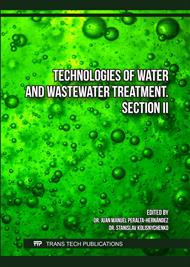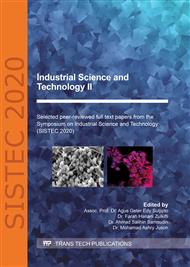[1]
Iskandar, M. J., Baharum, A., Anuar, F. H., & Othaman, R. (2017). Palm oil industry in South East Asia and the effluent treatment technology—A review. Environmental Technology & Innovation.
DOI: 10.1016/j.eti.2017.11.003
Google Scholar
[2]
Gao, D., Liu, L., Liang, H., & Wu, W. M. (2011). Aerobic granular sludge: characterization, mechanism of granulation and application to wastewater treatment. Critical reviews in biotechnology, 31(2), 137-152.
DOI: 10.3109/07388551.2010.497961
Google Scholar
[3]
Margot, J., Lochmatter, S., Barry, D. A., & Holliger, C. (2016). Role of ammonia-oxidizing bacteria in micropollutant removal from wastewater with aerobic granular sludge. Water Science and Technology, 73(3), 564-575.
DOI: 10.2166/wst.2015.514
Google Scholar
[4]
Liu, L., Li, W. W., Sheng, G. P., Liu, Z. F., Zeng, R. J., Liu, J. X., ... & Lee, D. J. (2010). Microscale hydrodynamic analysis of aerobic granules in the mass transfer process. Environmental science & technology, 44(19), 7555-7560.
DOI: 10.1021/es1021608
Google Scholar
[5]
Jemaat, Z., Suárez-Ojeda, M. E., Pérez, J., & Carrera, J. (2013). Simultaneous nitritation and p-nitrophenol removal using aerobic granular biomass in a continuous airlift reactor. Bioresource technology, 150, 307-313.
DOI: 10.1016/j.biortech.2013.10.005
Google Scholar
[6]
Jemaat, Z., Suárez-Ojeda, M. E., Pérez, J., & Carrera, J. (2014). Sequentially alternating pollutant scenarios of phenolic compounds in a continuous aerobic granular sludge reactor performing simultaneous partial nitritation and o-cresol biodegradation. Bioresource technology, 161, 354-361.
DOI: 10.1016/j.biortech.2014.03.071
Google Scholar
[7]
Ramos, C., Suárez-Ojeda, M. E., & Carrera, J. (2016). Long-term performance and stability of a continuous granular airlift reactor treating a high-strength wastewater containing a mixture of aromatic compounds. Journal of hazardous materials, 303, 154-161.
DOI: 10.1016/j.jhazmat.2015.10.031
Google Scholar
[8]
Sarma, S. J., & Tay, J. H. (2018). Aerobic granulation for future wastewater treatment technology: challenges ahead. Environmental Science: Water Research & Technology, 4(1), 9-15.
DOI: 10.1039/c7ew00148g
Google Scholar
[9]
Franca, R. D., Pinheiro, H. M., van Loosdrecht, M. C., & Lourenço, N. D. (2018). Stability of aerobic granules during long-term bioreactor operation. Biotechnology Advances, 36(1), 228-246.
DOI: 10.1016/j.biotechadv.2017.11.005
Google Scholar
[10]
Zhou, D., Liu, M., Wang, J., Dong, S., Cui, N., & Gao, L. (2013). Granulation of activated sludge in a continuous flow airlift reactor by strong drag force. Biotechnology and bioprocess engineering, 18(2), 289-299.
DOI: 10.1007/s12257-012-0513-4
Google Scholar
[11]
Long, B., Yang, C. Z., Pu, W. H., Yang, J. K., Liu, F. B., Zhang, L., & Cheng, K. (2015). Rapid cultivation of aerobic granular sludge in a continuous flow reactor. Journal of Environmental Chemical Engineering, 3(4), 2966-2973.
DOI: 10.1016/j.jece.2015.10.001
Google Scholar
[12]
Devlin, T. R., & Oleszkiewicz, J. A. (2018). Cultivation of aerobic granular sludge in continuous flow under various selective pressure. Bioresource technology, 253, 281-287.
DOI: 10.1016/j.biortech.2018.01.056
Google Scholar
[13]
Qi, K., Li, Z., Zhang, C., Tan, X., Wan, C., Liu, X., ... & Lee, D. J. (2020). Biodegradation of real industrial wastewater containing ethylene glycol by using aerobic granular sludge in a continuous-flow reactor: Performance and resistance mechanism. Biochemical Engineering Journal, 107711.
DOI: 10.1016/j.bej.2020.107711
Google Scholar
[14]
Juang, Y. C., Adav, S. S., Lee, D. J., & Tay, J. H. (2010). Stable aerobic granules for continuous-flow reactors: precipitating calcium and iron salts in granular interiors. Bioresource Technology, 101(21), 8051-8057.
DOI: 10.1016/j.biortech.2010.05.078
Google Scholar
[15]
Liu, H., Li, Y., Yang, C., Pu, W., He, L., & Bo, F. (2012). Stable aerobic granules in continuous-flow bioreactor with self-forming dynamic membrane. Bioresource Technology, 121, 111-118.
DOI: 10.1016/j.biortech.2012.07.016
Google Scholar
[16]
Jemaat, Z., Suárez-Ojeda, M. E., Pérez, J., & Carrera, J. (2014). Partial nitritation and o-cresol removal with aerobic granular biomass in a continuous airlift reactor. Water research, 48, 354-362.
DOI: 10.1016/j.watres.2013.09.048
Google Scholar
[17]
Cozma, P., & Gavrilescu, M. (2012). Airlift reactors: applications in wastewater treatment. Environmental Engineering & Management Journal (EEMJ), 11(8).
DOI: 10.30638/eemj.2012.189
Google Scholar
[18]
van Loosdrecht, M. C., Nielsen, P. H., Lopez-Vazquez, C. M., & Brdjanovic, D. (Eds.). (2016). Experimental methods in wastewater treatment. IWA publishing.
Google Scholar
[19]
Kent, T. R., Bott, C. B., & Wang, Z. W. (2018). State of the art of aerobic granulation in continuous flow bioreactors. Biotechnology advances.
DOI: 10.1016/j.biotechadv.2018.03.015
Google Scholar
[20]
de Sousa Rollemberg, S. L., de Oliveira, L. Q., Barros, A. R. M., Melo, V. M. M., Firmino, P. I. M., & dos Santos, A. B. (2019). Effects of carbon source on the formation, stability, bioactivity and biodiversity of the aerobic granule sludge. Bioresource technology, 278, 195-204.
DOI: 10.1016/j.biortech.2019.01.071
Google Scholar
[21]
Liu, Y., Liu, Z., Wang, F., Chen, Y., Kuschk, P., & Wang, X. (2014). Regulation of aerobic granular sludge reformulation after granular sludge broken: effect of poly aluminum chloride (PAC). Bioresource technology, 158, 201-208.
DOI: 10.1016/j.biortech.2014.02.002
Google Scholar
[22]
Chen, Y. Y., Ju, S. P., & Lee, D. J. (2016). Aerobic granulation of protein-rich granules from nitrogen-lean wastewaters. Bioresource Technology, 218, 469-475.
DOI: 10.1016/j.biortech.2016.06.120
Google Scholar
[23]
Long, B., Yang, C. Z., Pu, W. H., Yang, J. K., Liu, F. B., Zhang, L., Cheng, K. (2015). Tolerance to organic loading rate by aerobic granular sludge in a cyclic aerobic granular reactor. Bioresource technology, 182, 314-322.
DOI: 10.1016/j.biortech.2015.02.029
Google Scholar
[24]
Tay, J. H., Liu, Q. S., & Liu, Y. (2002). Characteristics of aerobic granules grown on glucose and acetate in sequential aerobic sludge blanket reactors. Environmental technology, 23(8), 931-936.
DOI: 10.1080/09593332308618363
Google Scholar
[25]
Du, S., Zhang, Z. H., Zhang, Y. F., & Jian, P. C. (2011). Characteristics of aerobic granular sludge cultivated by promoting and inhibiting filamentous bacteria. In Advanced Materials Research (Vol. 183, pp.1075-1079). Trans Tech Publications Ltd.
DOI: 10.4028/www.scientific.net/amr.183-185.1075
Google Scholar



